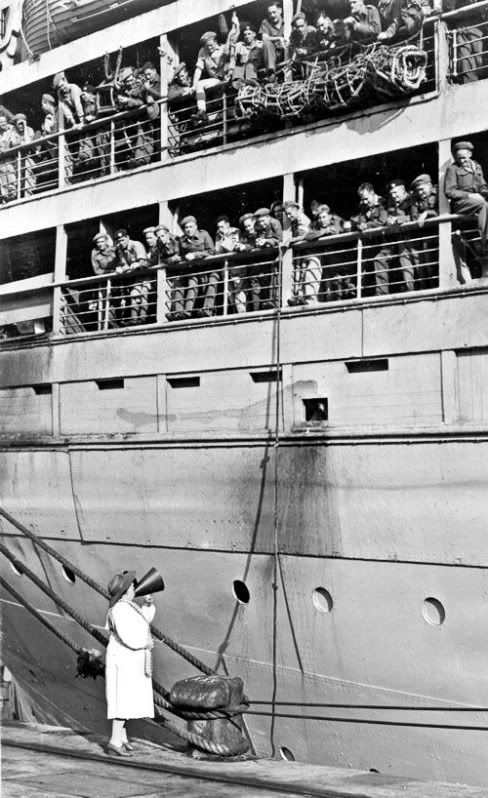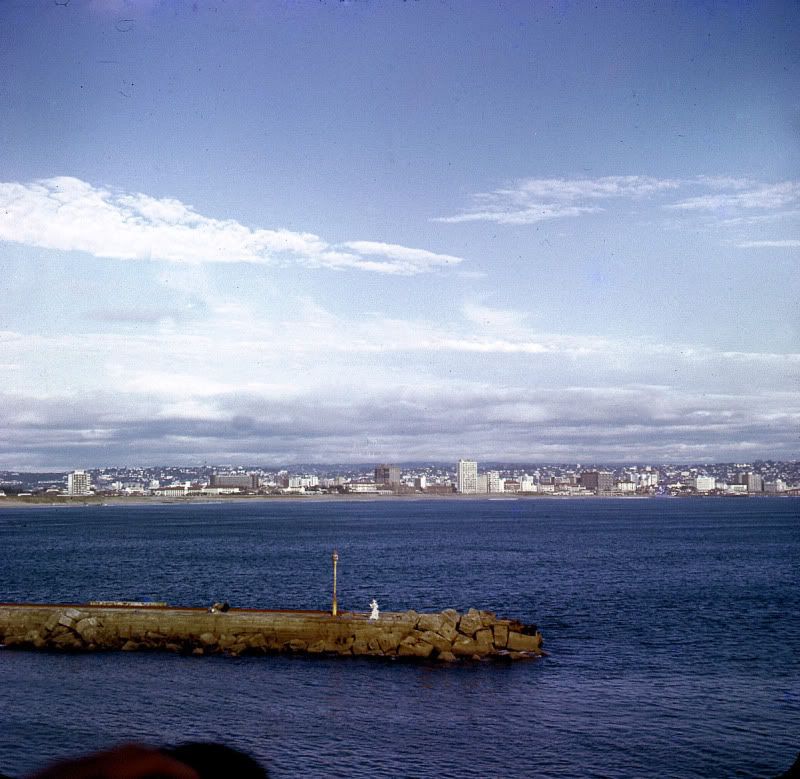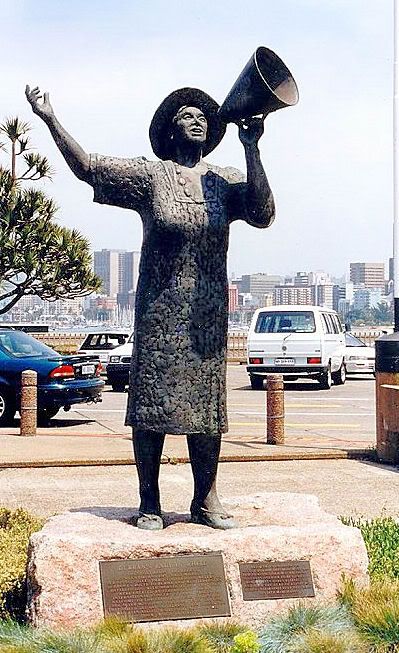By Troopship to the Far East - Part 3
By Troopship to the Far East - Part 3
Durban's Lady in White
I refer to the Lady in White in Part 1 (above). Here's some more about her.
Durban’s Lady in White is perhaps one of South Africa's most well known figures of the Second World War. The Lady in White, Mrs Perla Siedle Gibson became a well known figure to Allied troops at Durban harbour, which was South Africa’s busiest port during the war. Mrs Gibson was the daughter of a wealthy South African ship owner and studied as a young woman in Germany to be a soprano. She went on to give recitals in London and Manhattan.
Once described by Perla as her “wharfside work”, it began one day as she was seeing off a young Irish seaman who had been entertained by her family the day before. As his ship was departing, he shouted at her across the water, “Please sing something Irish.” She cupped her hands and started reciting the song, ‘When Irish Eyes are Smiling’. Throughout the years which followed she went on to sing to more than five thousand ships carrying an estimated quarter of a million Allied servicemen in total.
 Perla Siedle would often stand at the harbour dressed in her trademark white dress and hat singing to the passing ships with the aid of a megaphone which came from a torpedoed liner as a gift from grateful English troops. Americans would often request that she sing such songs as ‘God Bless America’ and ‘The Star-Spangled Banner’.
English troops often asked for ‘There’ll Always Be an England’, while Australians preferred her performances of ‘Waltzing Matilda’, and South Africans always requested their own national folk songs like ‘Sarie Marais’. Czechs, Poles and Greeks chose opera arias.
Soldier’s talk eventually led to The Lady in White’s fame spreading across the world, and ship captains would salute her as they were passing her. Perla Siedle was even known to U.S. soldiers as Kate Smith or Ma, to Britons as the Lady in White or the Soldiers’ Sweetheart, and to the Poles as the South African Nightingale. Perla Siedle was married to Air Sergeant Jack Gibson, last stationed at Foggia, Italy, and also had two sons and one daughter in the South African Army. She had sung goodbye to all of them, watching their ships move out of sight over the bar to the tune of her favourite closing number, ‘Auld Lang Syne’. Even after the loss of one of her own sons, she refused to stop singing to the troops.
Mrs Gibson died in 1971, a shortly before her 83rd birthday, and a stone cairn with a bronze plaque was erected on Durban’s North Pier in June 1972. The memorial was erected on the site where she would have stood, singing to “her boys”.
Perla Siedle would often stand at the harbour dressed in her trademark white dress and hat singing to the passing ships with the aid of a megaphone which came from a torpedoed liner as a gift from grateful English troops. Americans would often request that she sing such songs as ‘God Bless America’ and ‘The Star-Spangled Banner’.
English troops often asked for ‘There’ll Always Be an England’, while Australians preferred her performances of ‘Waltzing Matilda’, and South Africans always requested their own national folk songs like ‘Sarie Marais’. Czechs, Poles and Greeks chose opera arias.
Soldier’s talk eventually led to The Lady in White’s fame spreading across the world, and ship captains would salute her as they were passing her. Perla Siedle was even known to U.S. soldiers as Kate Smith or Ma, to Britons as the Lady in White or the Soldiers’ Sweetheart, and to the Poles as the South African Nightingale. Perla Siedle was married to Air Sergeant Jack Gibson, last stationed at Foggia, Italy, and also had two sons and one daughter in the South African Army. She had sung goodbye to all of them, watching their ships move out of sight over the bar to the tune of her favourite closing number, ‘Auld Lang Syne’. Even after the loss of one of her own sons, she refused to stop singing to the troops.
Mrs Gibson died in 1971, a shortly before her 83rd birthday, and a stone cairn with a bronze plaque was erected on Durban’s North Pier in June 1972. The memorial was erected on the site where she would have stood, singing to “her boys”.
 Stone cairn with a bronze plaque erected in her honour on Durban’s North Pier near where I photographed her in October 1956. Below
Stone cairn with a bronze plaque erected in her honour on Durban’s North Pier near where I photographed her in October 1956. Below
 It was donated by the men of the Royal Navy and reads:
“To the memory of Perla Gibson “The Lady In White” who sang to countless thousands of British commonwealth and Allied Servicemen as they passed through Durban over the years 1940 to 1971 This tablet was presented by the Officers and Men of the Royal Navy.”
It was donated by the men of the Royal Navy and reads:
“To the memory of Perla Gibson “The Lady In White” who sang to countless thousands of British commonwealth and Allied Servicemen as they passed through Durban over the years 1940 to 1971 This tablet was presented by the Officers and Men of the Royal Navy.”
 In 1995 a statue of Perla was unveiled by Queen Elizabeth II and today it stands in a prominent place next to the Emtateni Centre, which is part of the Ocean Terminal Building on the Durban Harbour’s T-Jetty. The Perla Siedle Gibson Mobile Library was also founded to serve British seamen and a five room unit at the Highway Hospice was created with funds raised in her memory. The boarding establishment at Glenwood High School was named Gibson House after Perla’s son Roy and its colour is white in her honour.
In 1995 a statue of Perla was unveiled by Queen Elizabeth II and today it stands in a prominent place next to the Emtateni Centre, which is part of the Ocean Terminal Building on the Durban Harbour’s T-Jetty. The Perla Siedle Gibson Mobile Library was also founded to serve British seamen and a five room unit at the Highway Hospice was created with funds raised in her memory. The boarding establishment at Glenwood High School was named Gibson House after Perla’s son Roy and its colour is white in her honour.
Last edited by Warmtoast; 23rd Jun 2011 at 05:31.